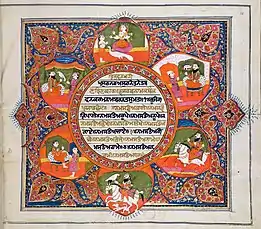Rudra Avtar
Rudra Avtar is a composition and epic poetry under title Ath Rudra Avtar Kathan(n), written by Guru Gobind Singh, present in Dasam Granth Sahib considered as second most important Scripture of Sikhs. This composition covers the most important war of Gurmat philosophy i.e fight between Bibek Buddhi and Abibek Budhi which is actually fight between truth and false, fight between Wisdom and Ignorance.[1]
| Part of a series on |
| Dasam Granth |
|---|
 |
| Dasam Granth - (ਦਸਮ ਗ੍ਰੰਥ ਸਾਹਿਬ) |
| Banis |
|
| Other Related Banis |
|
| Various aspects |
| Idolatry Prohibition |
This composition also covered the concept of Gyaan (Wisdom) and Dhyana(Attention) and is against Fake Ritualism and Practices.
Guru Gobind Singh sanctified and narrated the Life history of following two souls, which is designated them with title Rudra:
- Dattatreya - Hindu Monk
- Parshvanatha - 23rd Tirthankar of Jainism
Information
- This epic poetry was written at Anandpur Sahib,[2] probably in Samvat 1755/ 1698.
- This text is part of Bachitar Natak Granth, as per rubrics at the end. Although modern interpretations believed that portion of Guru Gobind Singh life, whom he refer Apni Katha is Bachitar Natak , viewing all the rest composition are independent form of it.
- This composition is present in all old Manuscripts i.e Mani Singh's, Motibagh's, Sangrur's and Patna's Manuscripts.[3]
- The Language of the composition is Hindi with mixture of Sanskrit words.[1]
- First six Chandds are Introductory. 849 Chands narrates Dattatreya and 359 Chandds narrates about Paras Nath.
- Unlike, Chandi Charitar and Krishna Avtar, The source of narration of Rudra Avtar are not any of 36 Puranas.[1]
Concept of Rudra in Sikhism
रुद्र धिआन गिआन सतिगुर के कबि जन भल्य उनह जो गावै ॥
With Rudra's attention and the spiritual wisdom of the True Guru, says BHALL the poet, these may be counted. (ਭਟ ਭਲ੍ਯ੍ਯ, ਪੰਨਾ 1396, ਸਤਰ 7, Guru Granth Sahib )Guru Granth Sahib covers the concept of Rudra Dhyaan. Every living being's surt/dhyaaan (or attention) can be directed in two ways, one towards one's body (outer world), and the other towards one's own self (source of attention). As long as our attention stays on our body only, and we loose connection with our self, we are incomplete (half or daal as in Gurbani). That is why we remain tense, confused and make wrong decisions. But those who are complete (The one as in Gurbani), their attention is focused on the source of attention itself (self) and thus, they are immune to any influence of outside world such as vices. Such a one-mindedness and focus is called Rudra Dhyaan. From such a dhyaan, the thoughts that sprout are all under divine hukam (and are not self-conceived). Consequently, Hukam itself is called Rudra.
In Dasam Granth, Rudra and Shiva are generic terms while Mahadev is the name of one person, whom people call Rudra or Shiva. In Gurmat Philosophy, Mahadev was a Yogi who was dweller of Himalayas. In Hindu Myth, Mahadev is also called Shiv or Rudra but in Gurmat philosophy, Shiv term does not come for Mahadev, because Shiv is Nirankar (Formless). In Chopai, Guru Gobind Singh cleared it as: Mahadev ko kehat sada shiv, nirankar ka cheenat nahin bhiv.[4] Guru Gobind Singh refers Mahadev/Shiva in following lines:
शिव सहंस बरख लौ जोग कीन ॥ तजि नेह गेह बनबास लीन ॥
Shiva practiced Yoga for thousands of years; he left his home and all attachment and resided in the forest;
ਬਹੁ ਕੀਨ ਜੋਗਿ ਤਹ ਬਹੁ ਪ੍ਰਕਾਰ ॥ ਨਹੀ ਤਦਿਪ ਤਾਸ ਲਹਿ ਸਕਾ ਪਾਰ ॥੮੨॥
बहु कीन जोगि तह बहु प्रकार ॥ नही तदिप तास लहि सका पार ॥८२॥
References
- Dasam Granth, S.S. Kapoor, Page 17
- Sri Dasam Granth Sahib:Q & A, Kamalroop Singh
- Sikh Religion, Culture and Ethnicity, C. Shackle, Arvind-Pal Singh Mandair, Gurharpal Singh
- Line 392, Chopai Sahib, Guru Gobind Singh